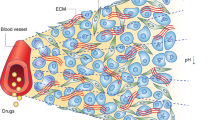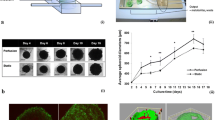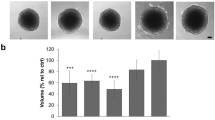Abstract
EMT6 multicellular spheroids were introduced into the peritoneal cavities of mice and allowed to become vascularised, resulting in solid spherical tumours. The necrotic cores of the initially avascular spheroids were replaced by vascularised tumour tissue but the outer zones of the spheroids failed to become vascularised. The presence of both vascular and avascular components in each spheroid allowed the role of the vasculature in the antitumour action of flavone acetic acid (FAA) to be determined. Eighteen hours after treatment with FAA 0.8 mmol kg-1, the vascularised core became necrotic and haemorrhagic, while the outer avascular zone remained viable. Tumour cells which were infiltrating superficial sub-mesothelial fat did not become necrotic despite the presence of numerous thrombi in associated vessels. Injection of two fluorescent vascular markers, the first (Hoechst 33342) together with FAA, and the second (10-nonyl acridine orange) 4 h later, demonstrated that there is a marked loss of blood flow in the spheroids. These results provide further evidence that FAA kills blood vessel-dependent tumour cells by interrupting the tumour blood supply.
Similar content being viewed by others
Author information
Authors and Affiliations
Rights and permissions
About this article
Cite this article
Zwi, L., Baguley, B., Gavin, J. et al. The use of vascularised spheroids to investigate the action of flavone acetic acid on tumour blood vessels. Br J Cancer 62, 231–237 (1990). https://doi.org/10.1038/bjc.1990.266
Issue Date:
DOI: https://doi.org/10.1038/bjc.1990.266
- Springer Nature Limited
This article is cited by
-
Flavone acetic acid induces a G2/M cell cycle arrest in mammary carcinoma cells
British Journal of Cancer (1999)
-
Interaction between endotoxin and the antitumour agent 5,6-dimethylxanthenone-4-acetic acid in the induction of tumour necrosis factor and haemorrhagic necrosis of colon 38 tumours
Cancer Chemotherapy and Pharmacology (1994)
-
Nitric oxide: its production in host-cell-infiltrated EMT6 spheroids and its role in tumour cell killing by flavone-8-acetic acid and 5,6-dimethylxanthenone-4-acetic acid
Cancer Chemotherapy and Pharmacology (1992)
-
Vascular attack as a therapeutic strategy for cancer
CANCER AND METASTASIS REVIEW (1990)




